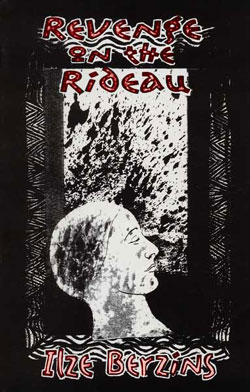
The wife of a respected Canadian judge, Leah Holm leads a pampered life. She spends her days having lunch and rejuvenating in an exclusive spa. In her diary and in her memory, however, she’s Leah Nusbaum, a 10-year-old Jewish girl who escaped the slaughter of her family and community when German authorities cleaned out the ghetto in occupied Liepāja, Latvia.
And then one day, decades and leagues removed from her past, she spies the Monster of Liepāja in Ottawa. Her mission becomes bringing the man she suspects to justice. But a fifth of the way into Ilze Berzins’ newest book, Revenge on the Rideau, Leah Holm is dead, floating face down in a hot tub at the My Lady Spa.
Who killed her—and why? Was it Clairelise Leowen, daughter of Erich von Leowen, the Baltic German baron Leah Holm suspects of ordering the extermination of her family? Was it Wilma Sprott, the mentally disturbed cleaning woman at the spa, a friend to Clairelise and who doesn’t like Leah? Or was it Judge Ken Holm, who is nearing retirement and pondering life with his sexy mistress, Ginette Ladouceur? Or was it one of several other characters?
Revenge on the Rideau takes place one winter near Ottawa’s famed Rideau Canal, billed by tourism promoters as the world’s longest skating rink. Berzins knows Ottawa and used the setting already in her 1999 murder mystery, Death in the Glebe. And Berzins also knows the broad outlines of Latvian history. Her autobiographical skewering of contemporary Latvian society, 1997’s Happy Girl, also gave readers a taste of who Berzins is—and we find plenty of her in this novel.
In a review of Death in the Glebe, Diana Kiesners made comparison to the "moral relativism" of that story’s fictional characters and the real people Berzins encountered in Happy Girl. We find that in Revenge in the Rideau, too. Few of the characters are outright lovable or off-putting.
But we also find similarity between Death and Revenge. Doreen Bell, the artist and amateur sleuth, is key in both tales, and she still is the romantic interest of a detective working on the case (in fact, Revenge alludes to Death at one point). Doreen in both murder mysteries and Berzins in Happy Girl also are dog lovers. And in Revenge, as in Death, women are victims of various kinds and most of the men can’t be trusted ("How come you’re so sure it’s a man?," Doreen asks her detective boyfriend, Barry Mullins, as they consider who might be the murderer. "Well, isn’t it always," Barry answers.).
Revenge is a relatively well-fashioned story, containing enough twists to keep the tale moving along at a comfortable pace. But few of the characters have engaging depth, perhaps a function of having too large a cast. As in Death, it’s Doreen who appears the most interesting and best-developed. Readers may hope that Berzins’ next work clearly becomes a Doreen Bell Mystery, more confidently using the character the author seems to know best. And while Revenge certainly makes use of Berzins’ artistic experience to describe places, people and the effects of light, it often seems a hasty job.
No publication is immune from technical errors. Berzins has worked to make Revenge cleaner than her previous efforts, but several of the final chapters are peppered with typographical errors, almost as if the rush to finish caused the author to drop her guard. And given its similarity to a made-for-TV movie (and that’s not necessarily a bad thing), a reader may be struck by a glaring continuity problem: is the name of the place Leah Holm dies My Lady Spa or Milady Spa?
At the same time, Berzins makes good use of the English language. A number of phrases are turned so well that they bring a smile to the reader. The overall flow of the story—particularly its resolution—is satisfying, especially for readers familiar with Berzins’ work so far. In the closing moments of the story, Doreen thinks to herself that "[s]he had always believed in happy. People were meant to be happy. She had always known that." Has Doreen found that which Berzins could not?
Dealing with the sensitive question of the Holocaust in Latvia and the process of Nazi-hunting as a backdrop for Revenge may be perceived by some readers as a risky move. But the novel doesn’t shock and perhaps could have gone out even farther onto the limb. As Berzins further explores her own background and develops the character of Doreen Bell, perhaps readers will be treated to an increasingly complex world.
(Corrected 12 APR 2001)
Details
Revenge on the Rideau
Ilze Berzins
Halifax, Nova Scotia: Albert Street Press, 2000
© 1995-2024 Latvians Online
Please contact us for editorial queries, or for permission to republish material. Disclaimer: The content of Web sites to which Latvians Online provides links does not necessarily reflect the opinion of Latvians Online, its staff or its sponsors.




